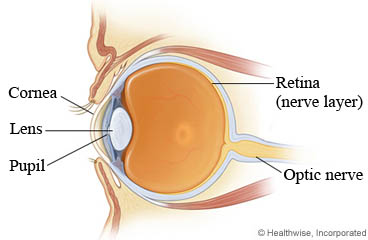UV Keratitis: Care Instructions

Overview
Keratitis is an inflammation of the cornea. The cornea is the outer, clear layer that covers the coloured part of your eye and pupil.
Ultraviolet light can burn your eye and cause keratitis. Bright sunlight can do this if you don't wear sunglasses that block ultraviolet light. This is especially true when the sun's rays reflect off snow or water, or when you look directly into the sun for a long time.
The problem can also be caused by bright light from welding equipment (also known as "welder's flash"), tanning booths, and sunlamps. These can burn your eyes if you don't wear eye protection.
Your doctor may have put a few drops of medicine into your eye to prevent infection and scarring. Your doctor may also have given you an eye patch or a special type of contact lens to wear while your eye heals.
It may take 24 hours after the burn to know how much of your eye was affected. Your vision may be blurry and your eye may hurt and feel irritated. These symptoms should start to get better within a few days.
Follow-up care is a key part of your treatment and safety. Be sure to make and go to all appointments, and call your doctor or nurse advice line (811 in most provinces and territories) if you are having problems. It is also a good idea to know your test results and keep a list of the medicines you take.
How can you care for yourself at home?
- If your doctor gave you eyedrops, use them as directed. Antibiotic eyedrops help prevent infection and scarring. Use the medicine for as long as your doctor tells you to, even if your eye starts to look and feel better. Keep the bottle tip clean. Do not let it touch the eye area.
- Be sure to only use the eyedrops your doctor prescribed. Do not use over-the-counter eyedrops. They may make your symptoms worse.
- To put in eyedrops:
- Tilt your head back, and pull your lower eyelid down with one finger.
- Drop or squirt the medicine inside the lower lid.
- Close your eye for 30 to 60 seconds to let the drops move around.
- Do not touch the eyedropper tip to your eyelashes or any other surface.
- Put a cold face cloth over your eye to help reduce swelling. Do this for 15 minutes 3 or 4 times a day for the first 24 to 48 hours after a burn to your eye. If you use a small ice pack, place a cloth between the ice and your skin. Do not use chemical cooling packs on or near your eye. If the pack leaks, the chemicals could cause more harm to your eye. After the swelling goes down, put a warm face cloth over your eye to help relieve pain.
- Do not wear contact lenses or eye makeup until your doctor says it is okay. If you were wearing disposable contacts when the burn happened, throw them away. Use a new pair when your eye has healed and it is safe to wear them again.
- Take an over-the-counter pain medicine, such as acetaminophen (Tylenol), ibuprofen (Advil, Motrin), or naproxen (Aleve), as needed. Read and follow all instructions on the label.
- If you feel like you have something in your eye, don't rub it. This could cause more harm to your eye.
To prevent ultraviolet burns to your eye:
- Wear sunglasses that block ultraviolet rays. Do this even on cloudy days and in the winter.
- Protect your eyes from the sun's glare when you are boating, sunbathing, or skiing.
- Wear a mask or goggles designed for welding if you are welding or are near someone who is welding.
- Use goggles to protect your eyes when you use tanning booths or sunlamps.
When should you call for help?
Call your doctor or nurse advice line now or seek immediate medical care if:
- You have signs of an eye infection, such as:
- Pus or thick discharge coming from the eye.
- Redness or swelling around the eye.
- A fever.
- You have new or worse eye pain.
- You have vision changes.
- It feels like there is something in your eye.
- Light hurts your eye.
Watch closely for changes in your health, and be sure to contact your doctor or nurse advice line if:
- You do not get better as expected.
Where can you learn more?
Go to https://www.healthwise.net/patientEd
Enter J017 in the search box to learn more about "UV Keratitis: Care Instructions".
Current as of: July 31, 2024
